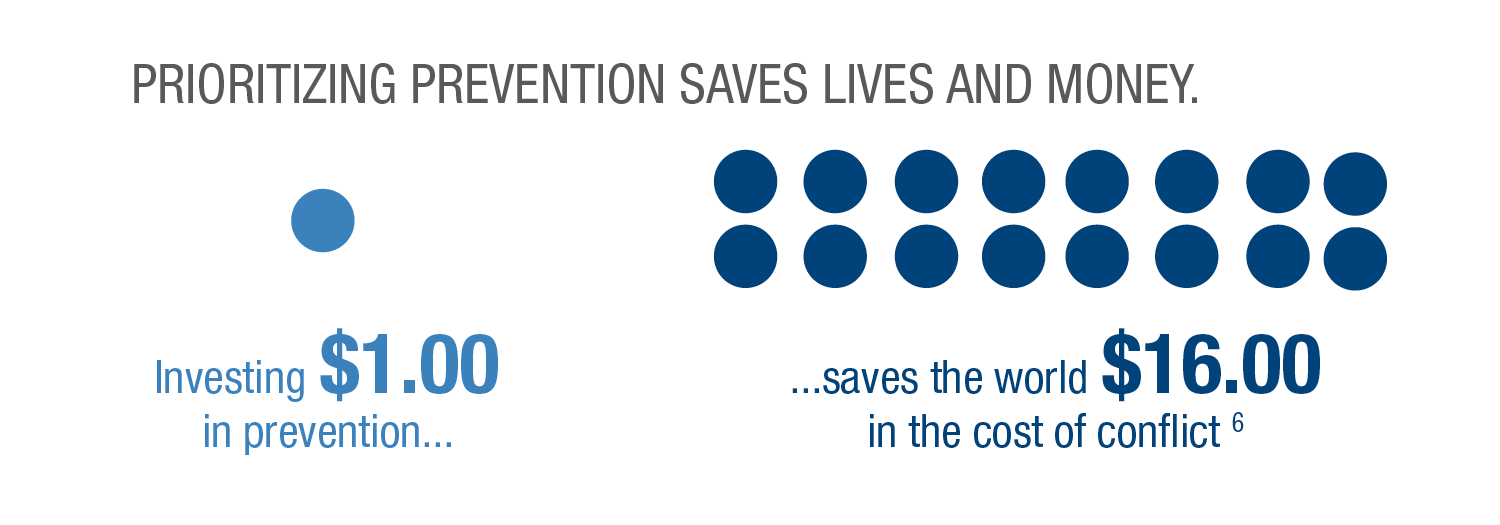The world is considerably less peaceful today than a decade ago. Recurring wars around the world show we cannot wait until a crisis escalates to respond. Failing to address brewing conflicts early puts greater demand on the United States to pursue costly military interventions later on. Congress should take a proactive approach towards prevention by investing in U.S. capacity to prevent violence.
The numbers paint a grim picture. According to the 2019 Global Peace Index (GPI), published by the Institute for Economics and Peace the world is considerably less peaceful today than a decade ago. Deteriorating peacefulness over the past decade, driven primarily by conflict in the Middle East, bucks a longer-term trend of falling global violence. We live in “a world in which the tensions, conflicts, and crises that emerged in the past decade remain unresolved,” the latest GPI finds. While global peacefulness improved very slightly in 2018, the root causes of many conflicts have not been addressed, and “the potential for violence to flare up remains very real.”
According to Brown University’s Cost of War project, [430,000 people have died](https://watson.brown.edu/costsofwar/files/cow/imce/papers/2018/Human Costs%2C Nov 8 2018 CoW.pdf) as a direct consequence of the wars in Afghanistan and Iraq alone. Despite these and other U.S. counterterrorism efforts around the world, the Task Force on Extremism in Fragile States found that violent extremism has grown steadily over the last decade, spreading across the Middle East, the Horn of Africa, and the Sahel.
As we have written before, the United States’ militarized foreign policy has exacerbated regional violence and instability. Airstrikes, drone attacks and military aid have failed to create sustainable security. They have caused spiraling civilian casualties, made the United States complicit in human rights abuses, and contributed to poverty, poor governance and corruption.
Prevention reduces violence, not military intervention.
Take the case of violent extremism again. The Task Force on Extremism in Fragile States concluded that attempting to defeat individual terrorists using military force will not end violence. “Effective measures to reduce extremism,” it argued, “should both make people’s lives better and demonstrate that their government is actively working to improve their lot.” Such measures include “alleviating real and perceived injustice,” fostering political inclusion, and involving communities in efforts to prevent violence—peacebuilding measures, in other words.
The human costs of violence are vast, and there is a significant economic cost as well. Conflict cost the world $14.1 trillion in 2018, according to the Global Peace Index. That number exceeds the money spent on health globally ($7.2 trillion in 2015) and the money spent on education ($14 trillion in 2014). It far outpaces the $267 billion that would be required annually to end global hunger.
But there are steps we can take to reduce the damage. Research by the Institute for Economics and Peace finds that each dollar invested in peacebuilding will lead to a $16 decline in the cost of conflict. Ultimately, prioritizing prevention saves U.S. taxpayer dollars, and it saves lives. Currently, the United States spends a relative pittance on peacebuilding efforts – less than 1% of what it spends on the Pentagon.
The United States must act to prevent violence. Congress should invest in conflict prevention.
Sources:
1 Institute for Economics and Peace. Global Peace Index 2019, 2019.
2 UNHCR. Global Trends 2018, 2019.
3 World Food Program. Fact Sheet: Hunger and Conflict, 2018.
4 UNGA. Report of the Secretary-General for the World Humanitarian Summit, 2016.
5 Costs of War Project, Brown University. Human Costs of the Post-9/11 Wars, 2018.
6 Institute for Economics and Peace. Measuring Peacebuilding Cost-Effectiveness, 2017.




